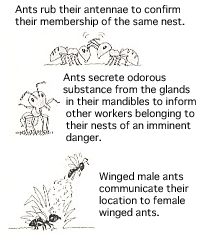| |
Why do ants march in procession?
Have you ever seen ants marching in procession? In such a procession,
a troop of as many as dozens of ants crawls as if they have formed a line.
Why on earth do ants march in procession?

A procession of ants of the Pristomyrmex pungens species: Ants of the
Pristomyrmex pungens species usually live in nests constructed under a
stone or in a space under a fallen tree. However, when the nest is damaged
or when food available near their nest has run short, they move in a procession
to find another suitable nest site.

|
|
From food source
discovery to marching in procession |
|
 |
|
|
|
|
Marching in procession is not seen in all species of ants. It is only
the ants of species that habitually carry food in a team of dozens of
ants that march in procession.
In such species*, a worker ant that has discovered a food source leaves
an odor trail as she walks back to the nest. To leave such an odor trail,
the ant secretes an odorous substance in drops from glands at the end
of her abdomen on her way back to the nest. On reaching the nest, her
excitement and feeding of the other workers stimulate them into activity,
but instead of dispersing at random from the nest entrance, the workers
march in procession because of following the odor trail left by the scout
ant.
*Such species include Pheidole fervida and Lasius Fuliginosus.
|
|
Communication methods of ants
Ants also secrete an odorous substance for purposes other than leaving
a trail from a discovered food source to the nest entrance.
For example, when they sense imminent danger, ants open their mandibles
widely. At this point, they secrete a special odorous substance from the
glands in their mandibles to inform other members in the nest of the impending
danger. Moreover, in Camponotus japonicus, winged male ants secrete an
odorous substance from the gland at the end of the abdomen to inform female
winged ants of their locations.
In addition to the above-mentioned communication methods, some ants rub
their body surfaces to send an auditory signal to other members of the
nest.
As mentioned in the above-described examples, in ants, odor and sound
made by rubbing their body surfaces correspond to language used by humans.
|
|
 |
|

Communication between the ants of the Messor aciculatus species: they
rub their antennae to smell the ant in front and confirm their membership
of the same nest.
|
|
|
![]()
![]()
![]()
![]() Ant
kingdom
Ant
kingdom![]() Structures
of ants
Structures
of ants![]() Winged
ants
Winged
ants![]() Marriage
flight
Marriage
flight![]() Ant
Kingdom from a queen
Ant
Kingdom from a queen![]() Egg-laying
by a queen
Egg-laying
by a queen![]() Ants
are strong
Ants
are strong![]() Procession
of ants
Procession
of ants![]() Ants
like sweets
Ants
like sweets![]() Ants
raising insects
Ants
raising insects![]() Slave-making
ants
Slave-making
ants![]() A
fight of ants
A
fight of ants![]() Ant
lion
Ant
lion![]() Hibernation
of ants
Hibernation
of ants![]() How
to raise ants
How
to raise ants![]() Contents
Contents![]() index
index




